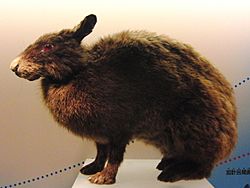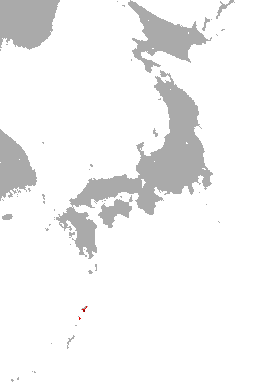Amami rabbit facts for kids
Quick facts for kids Amami Rabbit |
|
|---|---|
 |
|
| Conservation status | |
| Scientific classification | |
| Kingdom: | |
| Phylum: | |
| Class: | |
| Order: | |
| Family: | |
| Genus: |
Pentalagus
Lyon, 1904
|
| Binomial name | |
| Pentalagus furnessi (Stone, 1900)
|
|
 |
|
| Amami Rabbit range | |
The Amami Rabbit (Pentalagus furnessi), also known as the Ryukyu Rabbit, is a special type of dark-furred rabbit. It lives only on two small islands in Japan. These islands are called Amami Ōshima and Toku-no-Shima. They are located between southern Kyūshū and Okinawa in Kagoshima Prefecture.
People often call the Amami Rabbit a "living fossil". This means it is a living example of very old rabbits. These ancient rabbits once lived on the Asian mainland. However, they disappeared from there a long time ago. The Amami Rabbit is a unique survivor. It continues to live on these two small islands today.
Contents
Discover the Amami Rabbit
The Amami Rabbit is a very unique animal. It has some features that are different from most modern rabbits. This makes it a fascinating creature to study.
What Makes it Special?
The Amami Rabbit has short legs and large claws. These claws are good for digging. It also has a relatively small head and ears. Its fur is dark brown, which helps it blend into its forest home.
This rabbit is mostly active at night. It spends its days resting in burrows. These burrows are often hidden under tree roots or rocks. They help the rabbit stay safe from predators.
A Living Fossil Explained
The term "living fossil" means an animal that has changed very little over millions of years. It looks similar to its ancient ancestors. The Amami Rabbit is like a window into the past. It shows us what rabbits might have looked like long ago.
Its ancestors once roamed across the Asian continent. But as climates changed and new predators appeared, these ancient rabbits died out. The Amami Rabbit survived because it was isolated on these islands. This isolation protected it from many threats.
Where Amami Rabbits Live
The Amami Rabbit lives only on Amami Ōshima and Toku-no-Shima. These islands are part of the Ryukyu Islands chain. They are known for their rich and unique wildlife.
Island Home and Habitat
These islands have dense, evergreen forests. The forests provide plenty of food and shelter for the rabbits. They prefer areas with thick undergrowth. This helps them hide from animals that might hunt them.
The islands also have a warm, humid climate. This climate supports the lush vegetation. The rabbits rely on this vegetation for their diet. They eat various plants, including grasses and ferns.
Why Only These Islands?
The Amami Rabbit's survival on these specific islands is due to their isolation. Over time, the land bridges that connected the islands to the mainland disappeared. This left the rabbits stranded.
Being isolated meant they did not face competition from newer rabbit species. They also avoided many mainland predators. This allowed them to continue their ancient way of life.
Protecting the Amami Rabbit
Sadly, the Amami Rabbit is an endangered species. This means it is at risk of disappearing forever. Many efforts are being made to protect these special animals.
Threats to Survival
One major threat is habitat loss. Forests are sometimes cleared for farming or building. This reduces the space where the rabbits can live and find food.
Another big problem comes from introduced predators. Animals like mongooses and feral cats were brought to the islands. These animals hunt the Amami Rabbits, which are not used to such threats.
Conservation Efforts
Conservation groups and the Japanese government are working hard. They are trying to remove the introduced predators. This helps create a safer environment for the rabbits.
They are also working to protect the forests. Creating national parks and protected areas helps save the rabbit's habitat. Education programs also teach people about the importance of protecting this unique species.
By understanding and protecting the Amami Rabbit, we can help ensure its survival. This "living fossil" can continue to teach us about the past. It can also remind us about the importance of biodiversity.
See also
 In Spanish: Conejo de Amami para niños
In Spanish: Conejo de Amami para niños


